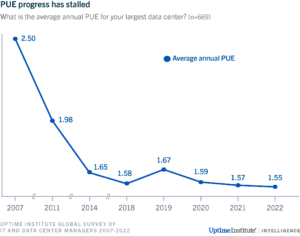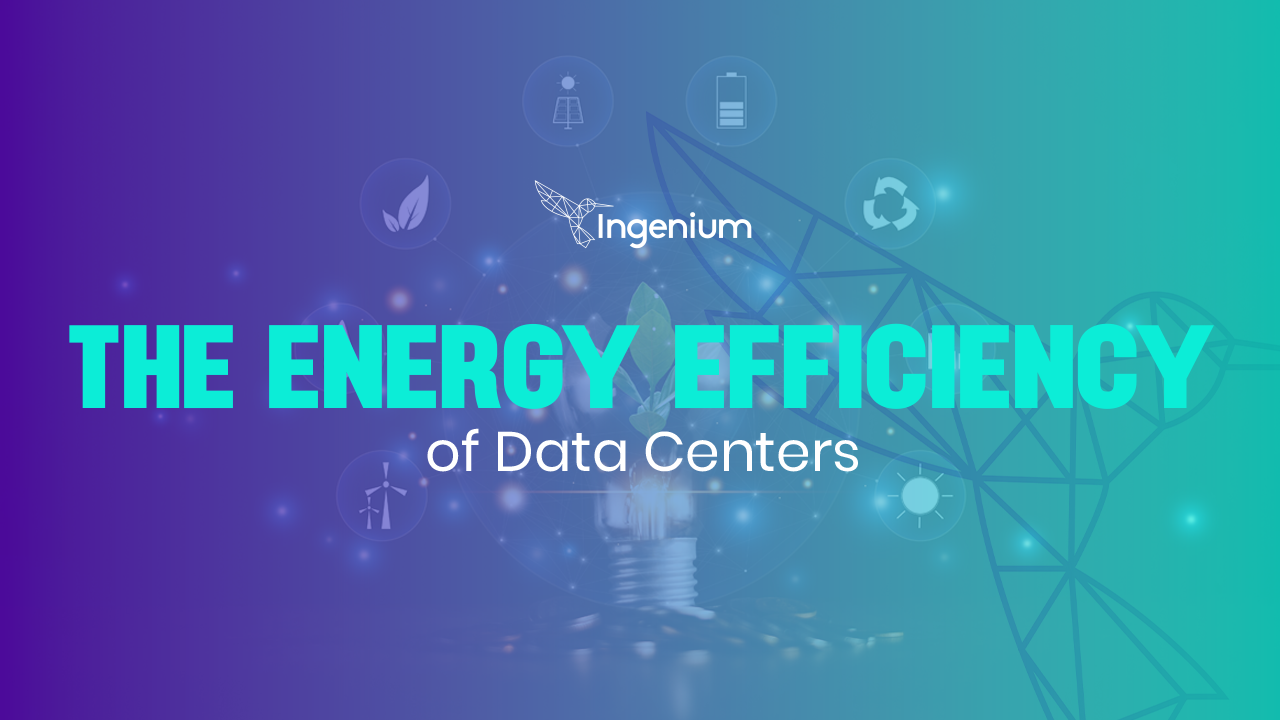The benefits of the Internet of Things, predictive data analysis, 5G, Artificial Intelligence and other technologies are already part of the business fabric, however, all these networks generate data that in recent years have increased exponentially highlighting the need to create sustainable data centers.
The Copenhagen Energy Efficiency Center predicts that by 2030 ICTs will account for more than 20% of global electricity demand, making sustainability a central hub for mission-critical center developers. In addition, the high energy consumption of these infrastructures and the expected growth in the coming years requires high efficiency in their operations.
 The Uptime Institute, in its Global Data Center Survey 2022 report 2022, revealed significant advances in energy efficiency according to the Power Usage Effectiveness (PUE) metric. This value can be in a range from 1.0 to infinity, 1.0 indicates the highest energy efficiency and by 2022 that number reached 1.55; A great advance considering that in 2007 it was 2.50, although that level of efficiency is practically the same since 2020.
The Uptime Institute, in its Global Data Center Survey 2022 report 2022, revealed significant advances in energy efficiency according to the Power Usage Effectiveness (PUE) metric. This value can be in a range from 1.0 to infinity, 1.0 indicates the highest energy efficiency and by 2022 that number reached 1.55; A great advance considering that in 2007 it was 2.50, although that level of efficiency is practically the same since 2020.
Similarly, the Uptime Institute revealed that 63% of respondents think that authorities will require data centers to publicly report environmental actions in the next 5 years. This trend will allow for greater sustainable practices that encourage the creation of specialized technologies that reduce the energy impact of data centers.
Sustainable solutions in refrigeration systems and energy supplies become a necessity and priority for the industry. Renewable energy is being used today, but better ways to cool data centers and recycle waste heat are also being investigated.
Considering that air conditioning and refrigeration systems account for around 40% of total electricity use in data centres, there are already technologies such as Free Cooling and its types (Direct fresh air Cooling, Rotating wheel heat exchanger, Heat pipe back rack, Water free cooling system) and Liquid Cooling that serves to reduce the load on the electric chiller, which leads to energy savings of cooling.
As is already known, air cooling is no longer enough, which opens the way to liquid cooling that significantly reduces noise pollution and can absorb 100% of the heat of the CPU, versus 30% of the air.
The important role of data centers and their high demand for energy urge the industry to make decisions so that environmental sustainability is a fundamental axis in the development of these infrastructures. These facilities are the backbone of the digital ecosystem, it is where the data that serves to detect a traffic jam on the road, watch the most popular movie on a streaming platform, or process medical data in a hospital center are stored and processed.
Tech giants such as Google, Facebook or Microsoft are increasingly increasing the use of renewable energy in their data center operations, there are even those who are building floating data centers that take advantage of seawater for cooling. Today, efforts are focused on optimizing energy efficiency in three ways: the computer equipment, the cooling system and the power supply system, according to the same report on data centers.
Sustainability as a central axis in the data center industry
Big Tech's biggest players are leading the sustainable development of data centers, for example, Microsoftannounced it is a carbon negative company by 2030, including its entire value chain. These actions, together with other international agreements, mean that data center developers must look for energy solutions.
 This trend, marked by the big players in the sector, caused a series of changes in the directives and strategies of data center operators, who require more options to buy renewable energy and improve the cooling of the operations center.
This trend, marked by the big players in the sector, caused a series of changes in the directives and strategies of data center operators, who require more options to buy renewable energy and improve the cooling of the operations center.
As we know, the data processing generated by the servers of a Data Center requires cooling by means of precision air conditioners robust enough for proper operation. And it is that by operating 24 hours a day, 365 days a year, the growth of the information they store and perform processes constantly make these infrastructures consume a lot of energy.
To counteract this, every day, data center developers like Ingenium, are focused on improving energy efficiency and ensuring that sustainability is a core strategy in the development of this business.
Free Cooling as an innovative element
We spoke with Isaac Jimenez, operation director of Stulzone of the leading manufacturers of air conditioning systems for mission-critical centers about new forms of cooling for data centers.
Integrating cooling closer to the thermal load and achieving greater energy efficiency is part of the mission of data center developers, as it translates into greater equipment capacity, lower energy consumption and economic savings that are also reflected in the balance with the environment. Free Cooling is a solution that is being increasingly used and has important advantages that we will discuss with the Stulz expert.
What is and what are the benefits of Free Cooling?
Let's first understand that availability in no reason has to be affected by improving the efficiency of air conditioning equipment, you have to find the middle point between these two verticals that often seem to run in opposite directions.
Free Cooling is an air conditioning option where we occupy the outside ambient temperature to cool the room where our active load is housed, and there are 2 main types:
Direct Free Cooling: This air conditioning option is the most efficient, however, you have to think that it cannot be applicable in all situations; It consists of entering the air from the outside that passes through a filtering system inside the room and absorbs the heat, generated by the critical load. Once the heat is swept away, the hot air leaves the room and is expelled into the atmosphere. What are the considerations to be taken into account? Air quality, pollution in the area, humidity level and criticality of our cargo.
Indirect Free Cooling: In this option we will also use the outdoor ambient temperature, but this time it will be to cool a medium that enters the room and absorbs the heat of the critical load. With this solution the level of availability is not affected.
The big question with these solutions is: in which cities is it feasible to do Free Cooling?
There is no manual that tells us the cities in which it can be done, the answer depends on 2 parameters the external temperature and mainly the desired internal temperature in the cold corridor, if the latter is intended to be of the order of 12 ° C, consequently the cities and hours a year are significantly reduced, however, if the setpoint in the cold aisle is placed at 25°C, cities and hours per year increase revealing significant savings in data center operation.
Will Liquid Cooling be implemented in LATAM in the coming years as a non-DC cooling solution of the research and development type, or of specific applications?
Liquid Cooling is a solution that its implementation must go hand in hand with the manufacturers of active equipment, since they supply the servers with the necessary preparations to flow the dielectric liquid inside and absorb the heat generated directly from the source of origin, achieving with the above better abatement capacities using a lower energy expenditure.
Ingenium and Stulz have extensive experience developing this type of solutions in Latin America. Contact us via email [email protected] or call us at +506 4001-9348 and we will gladly advise you.



